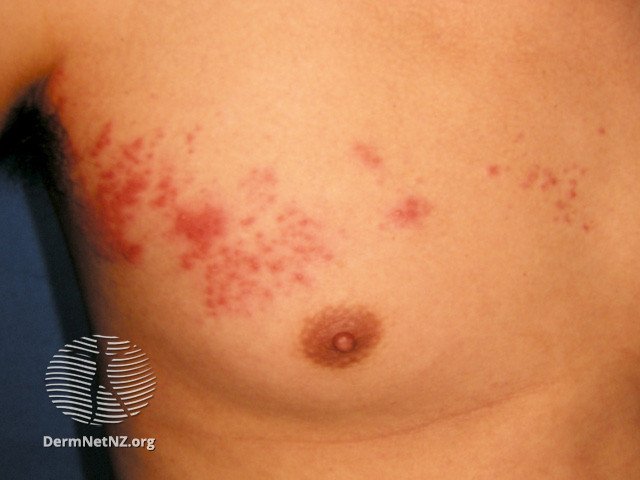
Shingles (Herpes Zoster)
Shingles manifests as a stripe of small water blisters with a red base that stops at the midline of the body.
Credit: DermNet NZ
What is shingles?
Shingles, also known as herpes zoster, is a painful rash caused by the reactivation of the varicella-zoster virus (VZV). This rash forms small blisters in a stripe, usually on one side of the body or face. Before the rash appears, there may be tingling or pain in the area. While shingles is generally not life-threatening, it can lead to serious complications, including persistent nerve pain and, if it affects the eye, potential blindness. The discomfort it brings often prompts individuals to seek medical treatment.
What causes shingles?
Shingles arises from the reactivation of the varicella-zoster virus, the same virus responsible for chickenpox. After a person recovers from chickenpox, the VZV remains dormant in nerve roots near the spine. Over time, the immune system typically suppresses the virus. However, factors weakening the immune system can allow the virus to reactivate. Potential triggers include:
Infections
Physical injuries
Pressure on nerve roots
Radiotherapy targeting the affected nerve root
Spinal surgery
What are the symptoms of shingles?
Before the rash appears, shingles might present as burning pain, itching, hypersensitivity, tingling, or numbness in a specific area. Some people may experience fever, fatigue, and headaches. Swollen lymph nodes near the rash site are also common. The subsequent rash starts as a cluster of red bumps, which develop into blisters and eventually crust over. Though less common, pain without an accompanying rash can also occur. The symptoms usually span 2-4 weeks. The chest, neck, forehead, and back are frequent sites of outbreak.
During an active shingles episode, an individual can transmit the virus to those who haven't had chickenpox or its vaccine.
A complication known as post-herpetic neuralgia, characterized by prolonged pain, itching, or burning at the rash site, can affect about one-third of patients over 40. Initiating treatment early can enhance the likelihood of prompt recovery.
How do I treat shingles?
While there's no cure for shingles, several treatments can alleviate symptoms, reduce their severity, or decrease the risk of complications. Options include:
Antiviral medications (e.g., acyclovir, valaciclovir, famciclovir)
Protective ointments, such as petroleum jelly
Pain relief medications including gabapentin
Oral steroids to mitigate inflammation
Oral antibiotics for secondary bacterial infections
For post-herpetic neuralgia, potential treatments encompass:
Prompt initiation of treatment
Local anesthetic applications
Topical capsaicin creams
Oral nerve pain medications (like amitriptyline, gabapentin, and pregabalin)
Botulinum toxin injections in the affected area
How do I prevent shingles?
Vaccination is the most effective preventive measure against shingles. Relevant vaccines include:
Chickenpox vaccine, ideally administered before contracting chickenpox
Shingles vaccines (Zostavax or Shingrix) for those who've had chickenpox. Even if you have already had shingles you can still get it again, so typically vaccination is still recommended.
Shingles can also cause blindness if it affects the eye (usually the shingles will be on the nose).
Credit: DermNet NZ
The initial blistering outbreak of shingles can be very robust.
Credit: DermNet NZ



